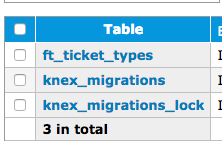Sql migrations using Knex
I need two tables for my next app. ft_ticket_types and ft_tickets.
Sometimes I like doing things the right way and sometimes I like to lie 🙊.
So I will use knex because is so freaking awesome.
MySql
I feel kinda nasty today so I will use MySql for the database. A couple of docker commands and I have
a mysql instance along with an adminer website because I do not feel THAT nasty to use the terminal 😅
After logging to adminer I will create my database: knex_tickets and it is time to make magic with knex.
Installing knex
1 | npm install knex mysql -S |
I have just install two packages from npm: knex and mysql. The -S is the shorcut for –save.
Knex init
Besides of been a great sql builder and migration tool, knex has a little cli incorporated.
One of her thousand commands (yes, Knex is a woman 👩✈) generate a configuration file for me.
1 | npx knex init |
It will create a knexfile.js file with some basic configuration in order to connect to a database.
I just replace some vaues and my file looks like the following:
1 | module.exports = { |
Please do not hack into my database 😒.
Knex Migrations
Another great command is migrate:make it will generate a migration for free, but it demands a name as a parameter.
1 | npx knex migrate:make create-type-ticket |
knex is smart and generate a folder called migrations and inside of it a file with the migration I wanted
20180308221110_create-type-ticket.js.
Writing migrations
Inside the file I can see two functions: up and down. The up will execute every time I execute a migration and the down when the rollback command is called.
1 | exports.up = (knex, Promise) => { |
First, both the up and down functions always must return a Promise. All the methods to interact with the database are inside the schema object like the createTable method that allow me to… well create a table 😒.
This method take 2 parameters: the name of the table and a function where I can write the fields I want for my new shiny table.
In the knex docs I can see a lot of methods which can generate the table content. I am using only two because I am lazy.
Basically I am saying this to knex: I want a table called ft_ticket_types and the table will contains 3 fields. An autoincrement id field, two text columns for the name and the code.
I do not need to set the name for the ID field because the increments function will use that value by default.
Executing migrations
Ok, everything looks great but where in the hell is my table? Time to run the migration using another awesome command.
1 | npx knex migrate:latest |
and it gives me good news!
1 | Batch 1 run: 1 migrations |
If I go to my adminer website I can see my new table.

Also two extra tables knex use to know what migrations are already executed.
I have made a huge tiny mistake
What about if I wrote a migration, executed but I do not want it anymore. Well looks like knex is so awesome she can make a rollback and save my ass.
1 | npx knex migrate:rollback |
Easy! Now my table is gone.